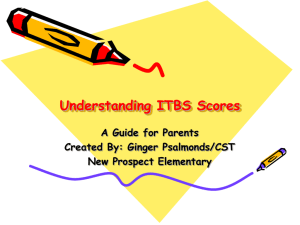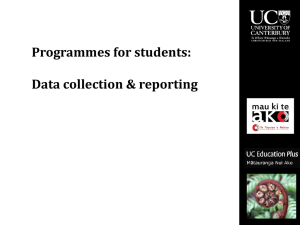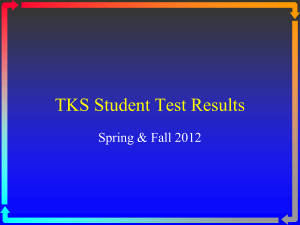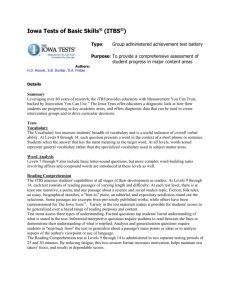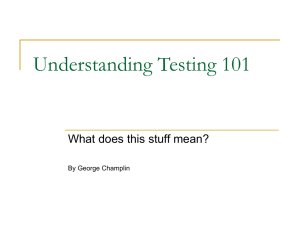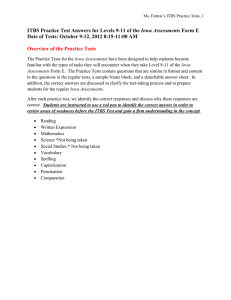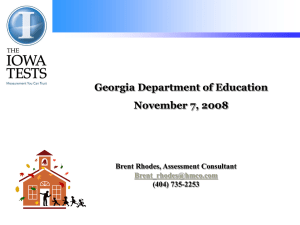Putting Reading First with Reading Recovery: Sustained Effects of the Reading Recovery
advertisement
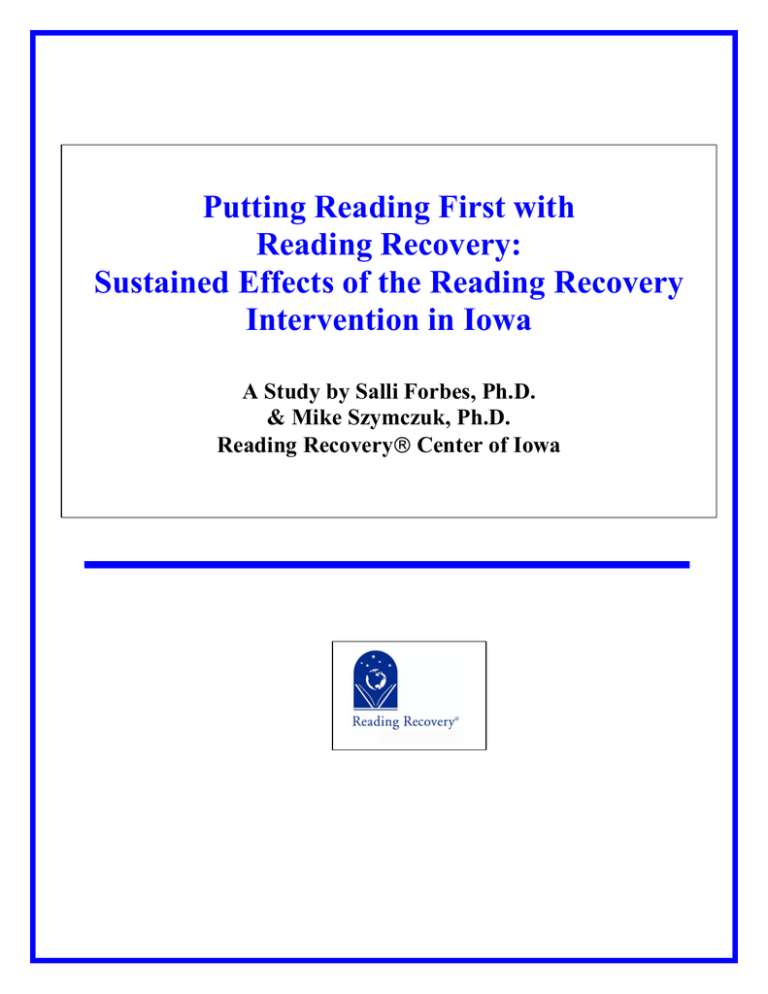
Putting Reading First with Reading Recovery: Sustained Effects of the Reading Recovery Intervention in Iowa A Study by Salli Forbes, Ph.D. & Mike Szymczuk, Ph.D. Reading Recovery Center of Iowa 2 What do we know about Reading Recovery results in Iowa? Reading Recovery (RR) is a research-based, highly effective, short-term intervention, which has demonstrated positive results in Iowa for the lowest achieving readers and writers in first grade. Since it was first introduced to Iowa in 1991, the implementation of Reading Recovery has expanded to districts across the state. Currently, over 5,000 Iowa first graders receive the intervention annually. Each year in Iowa 75% or more of the children who receive a full series of Reading Recovery lessons successfully achieve average or better reading and writing competency. When this happens the intervention is “discontinued”. These results have been replicated for several years. Do the students maintain the gains that were made in first grade in Reading Recovery? A few informal studies conducted within some of the Reading Recovery sites indicated that these students do sustain the gains they made. Those studies provide information for specific districts, but are not designed to answer some key questions about sustained effects of the Reading Recovery intervention for educators across the state. The study reported here provides strong evidence that the learning gains of Reading Recovery students are maintained, as measured by the Iowa Test of Basic Skills (ITBS). In this study we obtained the ITBS Reading Vocabulary, Reading Comprehension, and Total Reading scores in 3rd, 4th, and 5th grades for former Reading Recovery students. The students in the study received a full Reading Recovery program in selected districts in 1996-97, 199798, or 1998-1999. Districts in the study were selected from a list of all districts that had Reading Recovery all three years by a stratified random selection, based on district size. The 244 students in Cohort A received RR instruction in 1996-97 (in first grade). The 303 students in Cohort B received RR instruction in 1997-98. The 337 students in Cohort C received RR instruction in 1998-99. Results are reported for all full program students (including both those who were successfully discontinued and those who were not). Results for formerly discontinued students are also reported separately as well. The number of students’ scores is listed by grade level in Table 1. Third grade scores were collected for all three cohorts. Fourth grade scores were collected for Cohorts A and B. Fifth grade scores were collected for Cohort A only. __________________________________ Table 1 Number of Student Scores by Grade Level __________________________________ Grade Level 3rd 4th 5th ___________ ______________________ Discontinued 709 457 216 Full Program 874 547 244 The years that each cohort was instructed in Reading Recovery and the years that they were assessed with the ITBS are listed in Figure 1. Figure 1. Years of Reading Recovery Intervention and ITBS Testing for Each Cohort 1st Grade 3rd Grade ITBS 4th Grade ITBS 5th Grade ITBS A 1996-1997 1998-1999 1999-2000 2000-2001 B 1997-1998 1999-2000 2000-2001 C 1998-1999 2000-2001 Cohort 3 How do former Reading Recovery students perform in comparison to grade level peers within their schools of attendance in subsequent years? Approximately two-thirds of all full program students continue to perform within or above the average band of students within their grade level at their school of attendance. Looking at the full program students’ performance (both discontinued and not discontinued students) on the Reading Vocabulary subtest between 63.0-69.6% performed within or above the average band of their peers (see Figure 2). On the Reading Comprehension subtest between 67.0-71.7% of full program students performed within or above the average band of these same peers (see Figure 3). On the Reading Total score between 61.368.5% of full program students performed within or above the average band of their peers (see Figure 4). More than 2/3 of the formerly discontinued students scored within/above the average band. The former RR students were compared to the performance of all the students in their grade within their school of attendance on the Reading Vocabulary, Reading Comprehension, and Total Reading scores of the Iowa Test of Basic Skills. The average band performance was determined by calculating one standard deviation from the mean on each ITBS subtest for the grade level within each school of attendance. Figures 2, 3 and 4 illustrate the percentage of former RR students’ whose scores fell below, within, and above the average band performance for students at their schools of attendance on Reading Vocabulary, Reading Comprehension and Total Reading. The information is reported on formerly discontinued students and all full program students. Full program students include the discontinued students (those reading average performance in first grade), as well as full program students who did not reach average performance. Percent of Students Figure 2. Iowa Reading Recovery Sustained Effects Study ITBS Vocabulary Grades 3 - 5 Weighted Percentages Across Cohorts A, B and C 100 80 60 40 20 Grade Levels 0 3 4 5 3 4 5 Below Bldg. Avg. 28.1 23.9 24.1 30.3 25.4 25.8 Within Bldg. Avg. 69.7 73.5 70.4 67.8 72.2 68.9 Above Bldg. Avg. 2.2 2.6 5.6 1.9 2.4 5.3 Discontinued Total # of Discontinued Students = 709 Total # of Full Program Students = 884 Full Program 4 Percent of Students Figure 3. Iowa Reading Recovery Sustained Effects Study ITBS Reading Comprehension Grades 3 - 5 Weighted Percentages Across Cohorts A, B and C 100 80 60 40 20 Grade Levels 0 3 4 5 3 4 5 Below Bldg. Avg. 24.6 28.4 21.8 27.3 30.4 25 Within Bldg. Avg. 72.8 68.1 74.1 70.4 66.5 70.5 Above Bldg. Avg. 2.6 3.5 4.2 2.3 3.1 4.5 Discontinued Full Program Total # of Discontinued Students = 709 Total # of Full Program Students = 883 Percent of Students Figure 4. Iowa Reading Recovery Sustained Effects Study ITBS Reading Total Grades 3 - 5 Weighted Percentages Across Cohorts A, B and C 100 80 60 40 20 0 Grade Level 3 4 5 3 4 5 Below Bldg. Avg. 25.7 28 25 29.3 31.6 27 Within Bldg. Avg. 72 69.8 69.4 68.5 66.4 67.3 Above Bldg. Avg. 2.3 2.2 5.6 2.2 2 5.7 Discontinued Total # of Discontinued Students = 709 Total # of Full Program Students = 883 Full Program 5 Was there a shift in the distribution of scores as a result of the intervention? Did the distributions at the end of first grade and on the Reading Comprehension subtest of the ITBS in fourth grade demonstrate a range of abilities approaching a normal distribution? To answer this question the distribution of scores by stanine (Reading Recovery National Data Evaluation Center national norms, 2003) for all the full program students is displayed in a bar graph with the normal curve distribution superimposed in a line graph. Figure 5 illustrates that 98% of the Reading Recovery students in Cohorts A and B scored at stanine one on the text reading level of the Observation Survey at the beginning of first grade. By the end of first grade, the scores of those same students are distributed across several stanines (see Figure 6). The shift in distribution of text reading level scores demonstrates the unpredicted progress that was made as a result of Reading Recovery intervention instruction. Scores distributed by stanine for Cohorts A and B on the Reading Comprehension subtest of the ITBS in 4th grade form a distribution that approaches a normal curve distribution (see Figure 7). This demonstrates that RR not only shifts the achievement of the lowest performing students during the year of the intervention, but the students continue to perform so that the distribution of their scores approaches the normal distribution of student scores three years later. Percent of Students Figure 5. Iowa Reading Recovery Sustained Effect Study Fall 1st Grade Text Reading Level Stanine Distribution Weighted Percentage Across Cohort A & B Discontinued and Non-Discontined Students 100 90 80 70 60 50 40 30 20 10 0 Fall Distribution Stanine 1 Stanine 2 Stanine 3 Stanine 4 Stanine 5 Stanine 6 Stanine 7 Stanine 8 Stanine 9 Below 4 4 - 10 11 - 22 23 - 39 40 - 59 60 - 76 77 - 88 89 - 95 Above 95 97.8 Normal Curve Number of students = 878 4 7 12 17 2 0.1 0.1 20 17 12 Stanines 7 4 6 Figure 6. Iowa Reading Recovery Sustained Effects Study Spring 1st Grade Text Reading Level Stanine Distribution Weighted Percentage Across Cohort A & B Discontinued and Non-Discontinued Students Percent of Students 100 90 80 70 60 50 40 30 20 10 0 Stanine 1 Stanine 2 Stanine 3 Stanine 4 Stanine 5 Stanine 6 Stanine 7 Stanine 8 Stanine 9 Below 4 4 - 10 11 - 22 23 - 39 40 - 59 60 - 76 77 - 88 89 - 95 Above 95 Spring Distribution Normal Curve 12.7 12.5 22.9 33.3 5.6 9.6 1.6 0 1.8 4 7 12 17 20 17 12 7 4 Stanines Number of students = 817 Figure 7. Iowa Reading Recovery Sustained Effects Study 4th Grade ITBS Reading Comprehension Stanine Distribution Weighted Percentage Across Cohorts A & B Discontinued and Non-Discontinued Students 100 90 Percent of Students 80 70 60 50 40 30 20 10 0 4th Grade Normal Curve Stanine 1 Below 4 Stanine 2 4 - 10 Stanine 3 11 - 22 Stanine 4 23 - 39 Stanine 5 40 - 59 Stanine 6 60 - 76 Stanine 7 77 - 88 4.2 10.4 15.2 27.5 20.0 15.8 4.6 1.5 0.9 4 7 12 17 20 17 12 7 4 Number of students = 546 Stanines Stanine 8 Stanine 9 89 - 95 Above 95 7 What percentage of these former Reading Recovery students meet or exceed the state reading performance criterion—achieving the 41st percentile or better on the Reading Comprehension subtest of the ITBS in fourth grade. To answer this question, scores on the Reading Comprehension subtest of the ITBS were collected for all students in Cohorts A and B. Figure 8 demonstrates the percentage of students in the 1999-2001 biennium who performed at or above the proficiency level criterion for various groups. Sixty percent of all students nationally and 67.8% of all Iowa fourth grade students met or exceeded this proficiency criterion. Of all fourth grade students in the schools included in this study (sample buildings), 61.6% met the criterion. In the Reading Recovery sample 46.6% of the discontinued and 42.7% of all full program students met the criterion. A large percentage of the students who did not achieve the criterion percentile (41st NPR) were in the 4th stanine range. None of the Reading Recovery students would have been predicted to meet the proficiency criterion based on their performance at the beginning of first grade on the Observation Survey (97.8% of these students read at levels equivalent to the lowest 4% of students nationally). Reading Recovery intervention created a better outcome than would have been predicted for a large percentage of the students who were the lowest performers in reading and writing at the beginning of first grade. Figure 8. Percent of Fourth Grade Students Performing At or Above Proficient Level ITBS Reading Comprehension Test National Student Norms 1999-2001 Biennium Cohorts A & B 100 90 Percent of Students 80 70 60 50 40 30 20 10 0 Proficient & Above # of Full Program Students = 546 # of Discontinued students = 457 National Iowa Sample Bldgs Full Program Discontinued 60.00 67.80 61.60 42.70 46.60 Student Groups 8 Conclusions: • A very high percentage of the former Reading Recovery students continue to perform very well several years after the intervention. Approximately two-thirds perform as well or better than their average peers. • The distribution of scores of text reading level of former RR students at the beginning of first grade, before the intervention demonstrates that these were indeed the lowest performing students. Yet, after the intervention at the end of first grade, their range of achievement spans all stanine levels. Reading Recovery instruction changed the predicted outcome for most of these students. Even three years after the intervention the distribution of scores on the Reading Comprehension subtest of the ITBS is approaching a normal distribution. • The percentage of former RR students who achieve or exceed the Iowa proficiency level is much higher than would be predicted by their beginning first grade performance. The percentage of previously discontinued students (46.6%) is approaching the expected 60% for all students. This report demonstrates that not only does the intervention make a difference for many students who struggle to learn to read in the first grade, but also the gains that are made are sustained. A very large percentage of students continue to succeed many years after the intervention.
